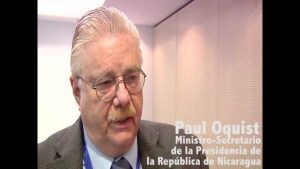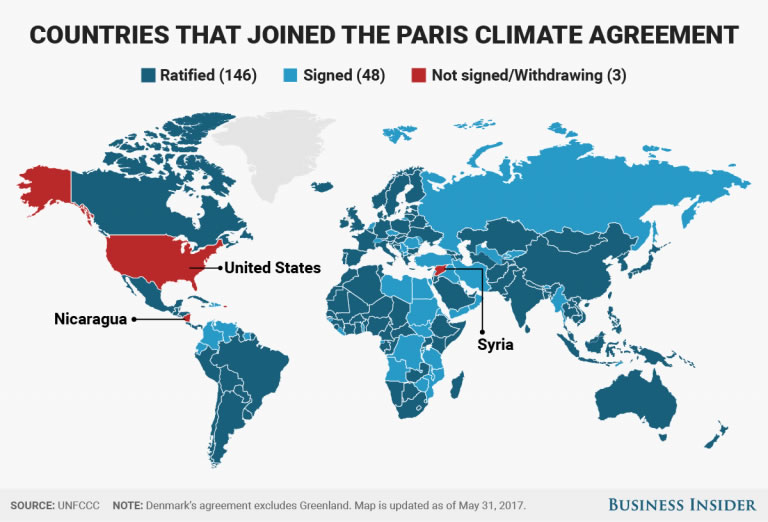At COP25 in Madrid in December 2019 Nicaragua’s Policy Minister Paul Oquist outlined to delegates the policy stance of his government to the issue of climate change and how to address it. In particular he explained the need to introduce into the system of adaptation and mitigation the notion of losses and gains, using the term ‘indemnification’, to redress the injustices of the historical causes of climate change. We consider this to be an important feature of any international mechanisms that seek to allocate funds for climate change action; and so we include his address here.
Dr. Paul Oquist Kelley Minister-Private Secretary for National Policies
Presidency of the Republic of Nicaragua
Translated by Tortillaconsal.com
December 11th 2019
Madam President, Your Excellencies, Ministers, Special Guests
The President of the Republic of Nicaragua, Comandante Daniel Ortega Saavedra,
and Vice President Compañera Rosario Murillo Zambrana, send their greetings and
best wishes for the success of this COP, aimed at achieving a higher level of
commitment and climate action.
Common but differentiated responsibilities and respective capacities are not
political positions but objective historical and contemporary realities. To
maintain that we are all historically responsible for climate change would be
tantamount to saying that we all participated equally in the Industrial
Revolution, as well as in the massive accumulation of capital resulting from
it. This was when most of our countries suffered at that time the yoke of
colonialism and neocolonialism, as well as the slave trade and the exploitation
of slave labour, which also contributed to the historical accumulation of those
responsible.
To maintain that we are all equally and universally responsible for greenhouse
gas emissions today, is equivalent to saying that the 100 countries with the
lowest emissions that account for 3% of the total, have the same responsibility
as the ten countries with the highest emissions that account for 72% of the
total. At the same time, it is equivalent to saying that most countries with
less than one ton of CO2 equivalent per capita have the same responsibility as
countries with 18 tons or 16 tons per capita.
My country, Nicaragua, contributes 0.03% of total global emissions, with a per
capita of 0.63 tons. Despite our negligible level of responsibility, we are
actively working on mitigation and adaptation, as well as loss and damage,
because we love Mother Earth, and we are concerned about the future of our
country and the world. Nicaragua has gone from 25% renewable energy in 2007 to
62% in 2018, while electricity coverage has expanded from 54% of households in
2007 to 95% in 2018. We are committed to the 30×30 initiative to restore 2.8
million hectares degraded due to a historic, active agricultural frontier. We
have committed in the Forest Carbon Partnership to capture 11 million tons of
CO2(e) [carbon dioxide equivalent] over the next five years. We are also adapting
a dry corridor to the new reality of climate change.
This effort has been in the context of average annual economic growth of 4.7%
between 2011 and 2017, the third highest rate among the countries of Latin
America and the Caribbean, accompanied by great social advances. These include
the reduction of the maternal mortality rate from 92.8 per hundred thousand in
2007 to 34.1 today, and the reduction of the infant mortality rate from 29 to
12 per thousand children born. Chronic malnutrition in schools was reduced by
66%. General poverty was reduced from 47.9% to 24.9%, and extreme poverty from
17.3% to 6.9%. Very important in this world, the GINI measure of inequality in
consumption went from 0.41 to 0.33. In 2007, Nicaragua ranked at 90 in the
Gender Gap Index of the World Economic Forum in Davos, rising to the rank of
number five in 2019, only below the Nordic countries. The indigenous and
Afro-descendant population of the Caribbean Coast and Upper Wanki River or
Coco, achieved the delimitation and titling of 37,800 square kilometers of
their ancestral lands, in 23 territories, each with its own territorial
government and control of its own resources.
However, Nicaragua, like 35 other countries around the world, has seen its
capacity to respond to climate change and to achieve sustainable development
goals undermined by coercive, unilateral, extraterritorial and illegal
measures, which even criminalize third parties that do not comply with the
illegal measures. Only sanctions approved by the United Nations Security
Council are legal in international law. The international system of bank
transfers is key to the de facto imposition of these illegal, unilateral,
coercive measures that violate the human and legal rights of individuals,
organizations and entire countries. There are also covert actions of
destabilization of governments and attempts at coups d’état, some successful
and others not. In the Middle East, several countries have been invaded or
bombed in wars of aggression. The Nuremberg court ruled that this type of war
is the supreme violation of international law and human rights, because it
contains within it the sum of all the evils of war. Even countries suffering
the consequences of climate change see their ability to respond to the future
shattered by catastrophic disasters and the lack of international compensation
mechanisms. All these phenomena have affected the respective response capacity
of developing countries.
Our Convention on Climate Change and the Paris Agreement are incomplete, because
they do not include an effective mechanism to finance response and recovery of
losses and damages. Mitigation reduces the risk of loss and damage; adaptation
reduces the impact of specific threats of loss and damage; loss and damage
themselves are the end result of the very climate change we are seeking to
minimize. Thus, we propose that the concept of losses and damages be elevated
to the same level as mitigation and adaptation, in order to receive resources.
The President of Nicaragua, Comandante Daniel Ortega Saavedra, in his message
to the United Nations General Assembly in 2015, stated that the only equitable
and effective way to finance losses and damages is for the countries and
corporations that have caused the problem and benefited from the use of carbon
to accumulate capital to compensate countries that suffer the consequences of
climate change without having caused it, in the proportion of their
responsibility. We have the data from 1880 to date, both for countries and for
corporations. Some people think this is a very radical proposal, but it is not.
The concept that whoever causes damage to another must then compensate the
other for the damage caused is called tort in common law. It is also in the
Napoleonic codes and in Sharia law. So too, all ethical systems, and all
religions of the world, contain the concept. However, the term most despised
and feared in these negotiations is the word “indemnification”.
The developing countries need enormous financial resources for the future, to face mitigation, adaptation and losses and damages. In Copenhagen in 2009, funding of US$100 billion per year starting in 2020 was proposed and reiterated in successive COPs. We should not accept as part of the US$100 billion accounts of past expenses, we cannot finance our projects with them. Nor can we accept that the market mechanisms of Article 6 of the Paris Agreement replace the US$100 billion annually. We must not accept the postponement of the date after having already waited 10 long years. What is needed from 2020 onwards are new, fresh, liquid resources with equal access for all developing countries. To guarantee these requisites, if these funds appear, they should be channelled through the financial mechanisms of the Convention, namely the Green Climate Fund, the GEF, the Adaptation Fund, and the Least Developed Countries Fund.
The year 2019 will be remembered like 1848, 1871, 1968 and 1989, as a
year when the street became important in world politics. Climate change is one
of the drivers of this phenomenon in many countries, with youth on the front
line. The 16-year-olds marching in the streets today will be 18 years old in
two more years, and no one will speak of that youth as passive, disinterested
and apolitical. A highly motivated voting youth can change the correlation of
political forces in many countries, being decisive in countries now evenly
split between opposing forces.
There is still a year before COP26 in 2020 but you see neither a working group
advancing the US$100 billion a year nor a road map. Only Secretary General
Antonio Guterres has asked President Emanuel Macron of France and Prime
Minister Andrew Holness of Jamaica to investigate the issue.
If the US$100 billion annual commitment in 2020 is broken, this could be termed the Fraud of the Century. In reality, much more is needed and US$100 billion has to be just a starting point. The US$100 billion myth has the aggravating factor that it reduced climate change spending and action in the critical decade of 2010 to date, and now we are suffering the consequences. What we cannot do at this time is to have another Lost Decade of financing and action on Climate Change.

